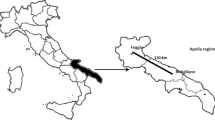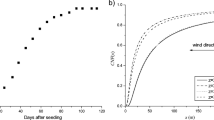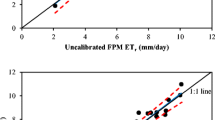Abstract
In this study, an experiment was performed to assess and rank different evapotranspiration models. This was done to estimate the daily actual evapotranspiration of corn using a single (Kc-single) and dual (Kc-dual) crop coefficients in the semiarid climate of Karaj, Iran, in 2014. Daily evapotranspiration calculations using one combination-based model, one pan evaporation-based model, nine temperature-based models, ten radiation-based models, and seven mass transfer-based models were compared to the lysimeter measurements. Considering the single-crop coefficient, the Hargreaves-M3 model (RMSE = 1.89 mm/day) in the temperature-based models, the Caprio (1974) model (RMSE = 1.99 mm/day) in the radiation-based models, and the Albrecht (1950) model (RMSE = 4.33 mm/day) in the mass transfer-based models were ranked first place. Moreover, the Hargreaves-M2 model (RMSE = 0.88 mm/day) in the temperature-based models, the Caprio (1974) model (RMSE = 1.17 mm/day) in the radiation-based models, as well as the Albrecht (1950) model (RMSE = 3.76 mm/day) in the mass transfer-based models using the dual-crop coefficient, provided the most accurate estimation of daily corn evapotranspiration as compared to the lysimeter measurements.







Similar content being viewed by others
References
Abtew W (1996) Evapotranspiration measurements and modeling for three wetland systems in South Florida. J Am Water Resour Assoc 32(3):465–473
Albrecht F (1950) Die Methoden zur Bestimmung Verdunstung der naturlichen Erdoberfläche. Arc Meteor Geoph Bioklimatol Ser B 2:1–38
Allen RG, Pereira LS, Raes D, Smith M (1998) Crop evapotranspiration guidelines for computing crop water requirements, FAO irrigation and drainage paper 56. Food and Agriculture Organization of the United Nations, Rome
Allen RG, Pereira LS, Howell TA, Jensen ME (2011) Evapotranspiration information reporting: I: factors governing measurement accuracy. Agric Water Manag 98(6):899–920
Baier W, Robertson GW (1965) Estimation of latent evaporation from simple weather observations. Can J Plant Sci 45(3):276–284
Berti A, Tardivo G, Chiaudani A, Rech F, Borin M (2014) Assessing reference evapotranspiration by the Hargreaves methodin North-Eastern Italy. Agric Water Manag 140:20–25
Blaney HF, Criddle WD (1962) Determining consumptive use and irrigation water requirements. U.S. Agriculture Research Service Technical Bulletin 1275, 59 p
Bormann H (2011) Sensitivity analysis of 18 different potential evapotranspiration models to observed climatic change at German climate stations. Clim Chang 104(3–4):729–753
Brockamp B, Wenner H (1963) Verdunstungsmessungen auf den Steiner See bei Münster. Dt Gewässerkundl Mitt 7:149–154
Caprio JM (1974) The solar thermal unit concept in problems related to plant development and potential evapotranspiration. In: Phenology and seasonality modeling. Springer, Berlin, pp 353–364
Chuanyan Z, Zhongren N (2007) Estimating water needs of maize (Zea mays L.) using the dual crop coefficient method in the arid region of northwestern China. Afric J Agric Res 2(7):325–333
Dehghanisanij H, Yamamoto T, Rasiah V (2004) Assessment of evapotranspiration estimation models for use in semi-arid environments. Agric Water Manag 64(2):91–106
Djaman K, Balde AB, Sow A, Muller B, Irmak S, N’Diaye MK, Saito K (2015) Evaluation of sixteen reference evapotranspiration methods under Sahelian conditions in the Senegal River Valley. J Hydrol Region St 3(1):139–159
Doorenbos J, Pruitt WO (1977) Guidelines for predicting crop water requirements. Food and Agriculture Organization of the UnitedNations (FAO), Rome. 144 p
Droogers P, Allen RG (2002) Estimating reference evapotranspiration under inaccurate data conditions. Irrig Drain Syst 16:33–45
Dugas WA, Bland WL (1989) The accuracy of evaporation measurements from small lysimeters. Agric For Meteorol 46(1–2):119–129
Farshi AA, Shariati MH, Jarollahi R, Ghaemi MH, Shabifar M, Tolaei MM (1997) Estimated water requirement major plants agricultural and horticultural of country. SWIR, Publication of Agriculture Education in Karaj. 394 p. (in Persian)
Gundalia Manoj J, Dholakia Mrugen B (2013) Dependence of evaporation on meteorological variables at daily time-scale and estimation of pan evaporation in Junagadh region. Am J Eng Res 10(2):354–362
Hargreaves GH, Samani ZA (1985) Reference crop evapotranspiration from temperature. Appl Eng Agric 1(2):96–99
Hunsaker DJ, Fitzgerald GJ, French AN, Clarke TR, Ottman MJ, Pinter PJ Jr (2007) Wheat irrigation management using multispectral crop coefficients. I. Crop evapotranspiration prediction. Trans ASAE 50(6):2017–2033
Irmak S, Irmak A, Jones JW, Howell TA, Jacobs JM, Allen RG, Hoogenboom G (2003a) Predicting daily net radiation using minimum climatological data. J Irrig Drain Eng ASCE 129(4):256–269
Irmak S, Irmak A, Allen RG, Jones JW (2003b) Solar and net radiation-based models to estimate reference evapotranspiration in humid climates. J Irrig Drain Eng ASCE 129(5): 336–347
Jensen ME, Haise HR (1963) Estimation of evapotranspiration from solar radiation. J Irrig Drain Eng ASCE 89:15–41
Jensen ME, Burman RD, Allen RG (1990) Evapotranspiration and irrigation water requirements. In: ASCE Manual No. 70. Am. Soc. Civil Engr., New York, NY.
Jones JW, Ritchie JT (1990) Crop growth models. Management of farm irrigation systems. Am Soc Agric Eng:63–89
Kong Q, Li G, Wang Y, Huo H (2012) Bell pepper response to surface and subsurface drip irrigation under different fertigation levels. Irrig Sci 30(3):233–245
Liu H, Wang X, Zhang X, Zhang L, Li Y, Huang G (2017) Evaluation on the responses of maize (Zea mays L.) growth, yield and water use efficiency to drip irrigation water under mulch condition in the Hetao irrigation district of China. Agric Water Manag 179:144–157
López-Urrea R, de Santa Olalla FM, Montoro A, López-Fuster P (2009) Single and dual crop coefficients and water requirements for onion (Allium cepa L.) under semiarid conditions. Agric Water Manag 96(6):1031–1036
Mahringer W (1970) Verdunstung Studien am Neusiedler See. J Theor Appl Climatol 18(1):1–20
Makkink GF (1957) Testing the penman formula by means of lysimeters. J Int Water Eng 11:277–288
Hansen S (1984) Estimation of potential and actual evapotranspiration. Nordic Hydrol 15(4–5):205–212
Meyer A (1926) Über einige Zusammenhänge zwischen Klima und Boden in Europa. Chem Erde 2:209–347
Mubiru J, Banda E, D’Ujanga F, Senyonga T (2007) Assessing the performance of global solar radiation empirical formulations in Kampala, Uganda. J Theor Appl Climatol 87(1–4):179–184
Muniandy JM, Yusop Z, Askari M (2016) Evaluation of reference evapotranspiration models and determination of crop coefficient for Momordica charantia and Capsicum annuum. Agric Water Manag 169:77–89
Nag A, Adamala S, Raghuwanshi NS, Singh R, Bandyopadhyay A (2014) Estimation and ranking of reference evapotranspiration for different spatial scales in India. J Indian Water Resour Soc 34(3):35–45
Nema MK, Khare D, Chandniha SK (2017) Application of artificial intelligence to estimate the reference evapotranspiration in sub-humid Doon valley. Appl Water Sci 7(7):3903–3910
Pandey PK, Dabral PP, Pandey V (2016) Evaluation of reference evapotranspiration methods for the northeastern region of India. J Soil water conserv 4(1):56–67
Penman LH (1948) Natural evaporation from open water, bare soil and grass. Proc R Soc Lond A A 193:120–145
Ritchie JT (1972) Model for predicting evaporation from a row crop with incomplete cover. Water Resour Res 8(5):1204–1213
Romanenko VA (1961) Computation of the autumn soil moisture using a universal relationship for a large area. Proc Ukr. Hydrometeorol Res., Inst. 3
Schendel U (1967) Vegetations wasserverbrauch und -wasserbedarf. Habilitation, Kiel. 137 p
Shahrokhnia MH, Sepaskhah AR (2013) Single and dual crop coefficients and crop evapotranspiration for wheat and maize in a semi-arid region. J Theor Appl Climatol 114(3–4):495–510
Singh VP (1989) Hydrologic systems: watershed modeling Prentice Hall Vol 2. 320 p
Spies RR, Franz KJ, Hogue TS, Bowman AL (2015) Distributed hydrologic modeling using satellite-derived potential evapotranspiration. J Hydrometeorol 16(1):129–146
Srivastava PK, Han D, Rico Ramirez MA, Islam T (2013) Comparative assessment of evapotranspiration derived from NCEP and ECMWF global datasets through weather research and forecasting model. Atmos Sci Lett 14(2):118–125
Tabari H (2010) Evaluation of reference crop evapotranspiration models in various climates. Water Resour Manag 24(10):2311–2337
Tabari H, Grismer M, Trajkovic S (2011) Comparative analysis of 31 reference evapotranspiration methods under humid conditions. Irrig Sci 31(2):107–117
Thornthwaite CW (1948) An approach towards a rational classification of climate. Geogr Rev 38(1):55–94
Trajkovic S (2007) Hargreaves versus penman–Monteith under humid conditions. J Irrig Drain Eng ASCE 133(1):38–42
Trajkovic S, Kolakovic S (2009) Evaluation of reference evapotranspiration models under humid conditions. Water Resour Manag 23(14):3057–3067
Turc L (1961) Water requirements assessment of irrigation, potential evapotranspiration: simplified and updated climatic formula. Ann Agron 12(1):13–49
USDA (2016) United States Department of Agriculture Foreign Agricultural Service. World Agricultural Production. Circular Series, pp 12–16
Willmott CJ (1981) On the validation of models. Phys Geogr 2(2):184–194
WMO (1966) Measurement and estimation of evaporation and evapotranspiration. Tech. Pap. (CIMO-rep) 83. Genf
Zacharias S, Heatwole CD, Coakley CW (1996) Robust quantitative techniques for validating pesticide transport models. Trans ASAE 39(1):47–54
Zhang H, Xiong Y, Huang G, Xu X, Huang Q (2017) Effects of water stress on processing tomatoes yield, quality and water use efficiency with plastic mulched drip irrigation in sandy soil of the Hetao Irrigation District. Agric Water Manag 179:205–214
Zhao C, Nan Z (2007) Estimating water needs of maize (Zea mays L.) using the dual crop coefficient method in the arid region of northwestern China. Afr J Agric Res 2(7):325–333
Acknowledgements
The authors wish to acknowledge the Agricultural Engineering Research Institute, Agricultural Research, Education and Extension Organization, Karaj, Alborz, Iran, for providing assistance to conduct this study. We also thank the editor and anonymous reviewers whose constructive comments improved the paper.
Author information
Authors and Affiliations
Corresponding author
Rights and permissions
About this article
Cite this article
Akhavan, S., Kanani, E. & Dehghanisanij, H. Assessment of different reference evapotranspiration models to estimate the actual evapotranspiration of corn (Zea mays L.) in a semiarid region (case study, Karaj, Iran). Theor Appl Climatol 137, 1403–1419 (2019). https://doi.org/10.1007/s00704-018-2634-y
Received:
Accepted:
Published:
Issue Date:
DOI: https://doi.org/10.1007/s00704-018-2634-y




